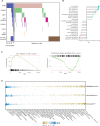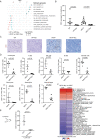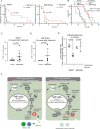MYC promotes immune-suppression in triple-negative breast cancer via inhibition of interferon signaling
- PMID: 36323660
- PMCID: PMC9630413
- DOI: 10.1038/s41467-022-34000-6
MYC promotes immune-suppression in triple-negative breast cancer via inhibition of interferon signaling
Abstract
The limited efficacy of immune checkpoint inhibitor treatment in triple-negative breast cancer (TNBC) patients is attributed to sparse or unresponsive tumor-infiltrating lymphocytes, but the mechanisms that lead to a therapy resistant tumor immune microenvironment are incompletely known. Here we show a strong correlation between MYC expression and loss of immune signatures in human TNBC. In mouse models of TNBC proficient or deficient of breast cancer type 1 susceptibility gene (BRCA1), MYC overexpression dramatically decreases lymphocyte infiltration in tumors, along with immune signature remodelling. MYC-mediated suppression of inflammatory signalling induced by BRCA1/2 inactivation is confirmed in human TNBC cell lines. Moreover, MYC overexpression prevents the recruitment and activation of lymphocytes in both human and mouse TNBC co-culture models. Chromatin-immunoprecipitation-sequencing reveals that MYC, together with its co-repressor MIZ1, directly binds promoters of multiple interferon-signalling genes, resulting in their downregulation. MYC overexpression thus counters tumor growth inhibition by a Stimulator of Interferon Genes (STING) agonist via suppressing induction of interferon signalling. Together, our data reveal that MYC suppresses innate immunity and facilitates tumor immune escape, explaining the poor immunogenicity of MYC-overexpressing TNBCs.
© 2022. The Author(s).
Conflict of interest statement
K.E.d.V. receives research funding from Roche/Genentech and is consultant for Macomics, both outside the scope of this manuscript. The other authors declare no potential conflict of interest.
Figures






References
-
- Bray F, et al. Global cancer statistics 2018: GLOBOCAN estimates of incidence and mortality worldwide for 36 cancers in 185 countries. Ca. Cancer J. Clin. 2018;68:394–424. - PubMed
-
- Dent R, et al. Triple-Negative Breast Cancer: Clinical Features and Patterns of Recurrence. Clin. Cancer Res. 2007;13:4429–4434. - PubMed
Publication types
MeSH terms
Substances
LinkOut - more resources
Full Text Sources
Molecular Biology Databases
Research Materials
Miscellaneous

